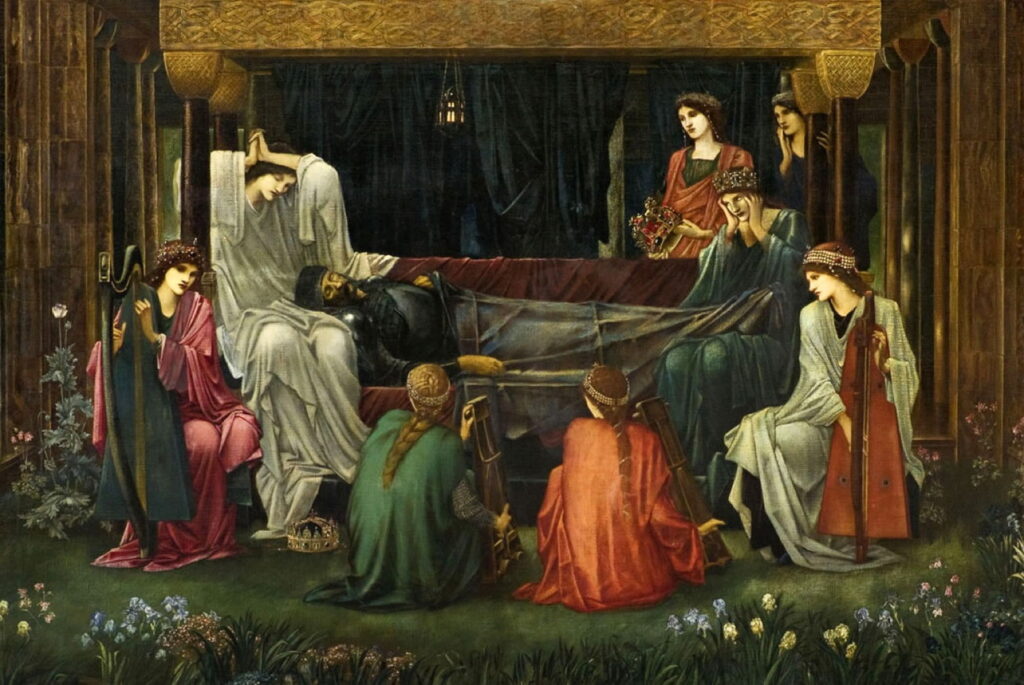Arthur: 13 The death of Arthur

Most puzzling of all about Malory’s book is that, despite its title of The Death of Arthur, after hundreds of pages of tales about the king and his knights, Arthur’s death is covered in just two pages.
Fatally wounded by the dying traitor Mordred, King Arthur had Sir Bedevere return his sword Excalibur to the lake where it had come from. Bedevere then carried the dying king on his back, to a barge waiting at the edge of the lake. The knight gently placed Arthur among the many ladies in the boat. They were wearing black hoods and weeping openly. Among them was a queen, who welcomed him as her brother, making her Morgan le Fay. As the barge was rowed away, Arthur told Bedevere that he was going away to the vale of Avalon, and the knight could no longer look to him for help.
The following morning Bedevere noticed there was a chapel and a hermitage nearby. Inside the chapel, the former Archbishop of Canterbury was kneeling low in front of a freshly made tomb. After discussion, the knight concluded that this contained the body of King Arthur. Malory then informs us that Arthur’s body had been brought there by Morgan le Fay, the Queen of North Wales, and the Queen of the Waste Lands, together with Nyneve, the chief Lady of the Lake. Sir Bedevere remained there as a humble servant to the former Archbishop, fasting and praying for the soul of King Arthur.
Edward Burne-Jones (1833–1898), The Last Sleep of Arthur in Avalon (1898), media and dimensions not known, Museo de Arte de Ponce, Ponce, Puerto Rico. Wikimedia Commons.
Edward Burne-Jones’ Last Sleep of Arthur in Avalon was completed shortly before the artist’s own death in 1898. This brings together the three queens and Nyneve who were to take the king to Avalon with a string quartet seated in front of Arthur’s deathbed (detail below), but there’s no sign of the barge that carried them across.
Edward Burne-Jones (1833–1898), The Last Sleep of Arthur in Avalon (detail) (1898), media and dimensions not known, Museo de Arte de Ponce, Ponce, Puerto Rico. Wikimedia Commons.
James Archer (1823–1904), The Death of King Arthur (c 1860), oil on canvas, dimensions and location not known. Wikimedia Commons.
In James Archer’s The Death of King Arthur from about 1860, the four women surround the dying Arthur, as the black boat approaches the beach behind them. At the right, the ghostly figure of an angel holding a chalice is materialising.
Frank William Warwick Topham (1838–1924), Voyage of King Arthur and Morgan Le Fay to the Isle of Avalon (1888), oil on canvas, 106.7 x 152.4 cm, Private collection. Wikimedia Commons.
For Frank Topham, painting in 1888, this final Voyage of King Arthur and Morgan Le Fay to the Isle of Avalon took place against a background of Camelot burning, and a rather closer relationship than you’d expect for half-siblings.
This left Sir Lancelot and Queen Guenevere, whose fates I will cover in the next article.
Reference
Dorsey Armstrong (translator and editor) & Sir Thomas Malory (2009) Morte Darthur, a new modern English translation, Parlor Press. ISBN 978 1 60235 103 5. (A superb translation based on the Winchester manuscript.)



